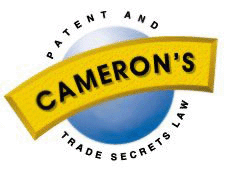
Procter & Gamble Co. et al. v.
Kimberly Clark of Canada Ltd.
citation(s): (1991), 40 C.P.R. (3d) 1
 |
Procter & Gamble Co. et al. v.
|
copyright 1997 Donald M. Cameron, Aird & Berlis
"The tests for anticipation as set out by Gibson J. in Reeves Brothers Inc. v. Toronto Quilting & Embroidery Ltd. (1978), 43 C.P.R. (2d) 15 (F.C.T.D.) at p. 157, have recently been commented on by the Court of Appeal in the Tye-Sil case. Decary J.A. at p. 12 (p. 361 C.P.R.) indicated that the tests had been used out of context and that the tests were not cumulative: Gibson J. had only enumerated various formulations for the test of anticipation retained in earlier decisions and his conclusion, really, is that there could be no finding of anticipation unless one met any, rather than each of these eight "tests"."
At p. 34
"The defendant has argued that there are two tests to determine anticipation. The first is that of determining whether the patent is disclosing something that is not new, namely, the equivalency of invention test, and the second is the "infringement test", which relates to the scope of the patent's claims. The defendant refers to William Hayhurst's article, "Recent Developments in Canadian Law: Intellectual Property" (1987) 19 Ottawa L. Rev. 155, and the Tye-Sil decision in support of their contention that there are two tests for anticipation. According to the defendant the first test for anticipation, the "equivalency of invention" test, is reflected in terms 1,3,4,5 and 6 of the Reeves Brothers decision, and the infringement test is reflected in items 2 and 7 of the decision, namely, give directions which will inevitably result in something within the claims and in the absence of explicit directions, teach an "inevitable result" which "can only be proved by experiments". I have the same problems with item 2 as Mr. Hayhurst in that it refers to "something within the claims"; that something may be within the claims and therefore anticipate, but fail to teach or provide what the patentee has accomplished. It would seem that in such a case the patentee has not limited his/her claim to what he/she invented. The plaintiffs maintain that there is no infringement test for anticipation, and in support of their assertion, refer to the Supreme Court of Canada's decision in Consolboard, supra. However, the defendant notes, as do I, that in Consolboard the Supreme Court applied both tests and found them not to be met. In this regard, I note the following comments from pp. 167-8, which are reproduced below:
"I agree that the information in the prior publication is not, for the purposes of practical utility, equal to that given in the patents in suit. The respondent contends that the proper test of an "anticipation" is that the claims in suit "cover" or "read on" what the prior document would have taught as of the date of the invention to one skilled in the area; "what infringes if later, anticipates if earlier": as Rinfret J. delivering the judgment of the Court in Lightening Fastener Co. Ltd. v. Colonial Fastener Co. Ltd. et al, {1933} 3 D.L.R. 348 at p. 352, {1933} S.C.R. 377 at p. 381, said: "But what amounts to infringement, if posterior, should, as a general rule, amount to anticipation, if anterior." In my view the claims in suit do more than merely read on the disclosure of the prior documents. Such disclosure does not contain clear instructions to do or make something that would infringe the patents in suit if carried out after the grant. Dr. Clark was doing more that simply following along old tracks."
According to the defendant the court applied the infringement test, commencing with the sentence, "Such disclosure" and found it not to be met.
I agree that a "bare infringement" test alone is improper with respect to anticipation because while an earlier publication may satisfy the "infringement test" in that the earlier publication may describe in a general way the basic concept of the invention, there may be insufficient information in the publication to be able to say, for example, that it gives clear and unmistakable directions to do what is contained in the claims. I am of the view that the tests for anticipation include those outlined in the Reeves Brothers decision as commented on by the Court of Appeal in Tye-Sil."
Return to:
Cameron's IT Law: Home Page; Index
Cameron's Canadian Patent & Trade Secrets Law: Home Page; Index